The six types of German hikers you're bound to see this summer
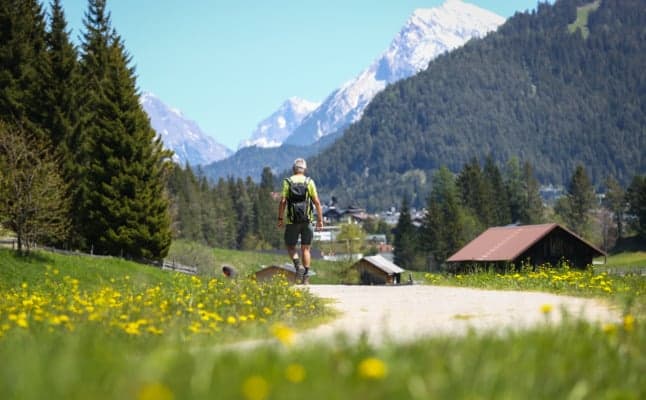
'Hiking is the new clubbing,' according to those in the know - but not all hikers in Germany are the same. Here are six types of hiker you might meet on the trails this summer.
The nature-loving hiker
Out of the city, into the wilderness: the priority for the nature-loving hiker is getting a taste of the great outdoors. This type of hiker is, at the moment at least, the most commonly spotted variety of hiker.
READ ALSO: Six great hiking tours in the northeast of Germany
In a recent survey, 95 percent of respondents said that “experiencing nature” was their primary reason for donning their hiking boots. But could it just be the threat of coronavirus that's causing people to march through forests, low mountain ranges and alpine meadows again? Not at all, according to German Hiking Institute chairman Klaus Erber. For more than 10 years, he's been observing a growth in the popularity of hiking for pleasure.
This is also borne out by the figures: while in 2020 ten percent said they went hiking “often”, a recent survey by the Allensbach Institute for Demoscopy shows that this has already crept up to 12 percent. A representative proportion of the German-speaking population aged 14 and over in the Federal Republic was surveyed between summer 2020 and spring 2021.
According to the survey, 46.3 percent get active in nature “from time to time”, compared to 45 percent in 2020, while 41.7 percent said they “never” go hiking, compared to 45 percent the previous year. According to the German Hiking Association, there are around 200,000 kilometres of hiking trails in Germany for people to enjoy, including a number of 'premium routes' selected by the association itself.
READ ALSO: REVEALED: 10 of the best hiking day trips from Munich
The age of the average nature hiker has also changed over time - "from 60-plus two decades ago to around 47 now," Erber explains. One reason is the larger proportion of families with children who are heading out into nature. The hiking expert and geographer does not believe that the trend will abate after Corona: "If they've had a positive experience, a large proportion of people will keep it up," he said.
The serious sports hiker
In contrast to leisure or nature hikers, sports hikers are in it for the adrenaline, not to mention a heavy dose of social kudos.
“For them, it's about wracking up the kilometres,” explains Erber. You'll most likely see this type of hiker competing for badges for each of the routes they complete. Sports hikers are often organised in associations and therefore travel in groups, but sometimes they are also lone warriors.
You'll also see them with trekking poles or other gear they've bought specifically for their beloved active hobby.
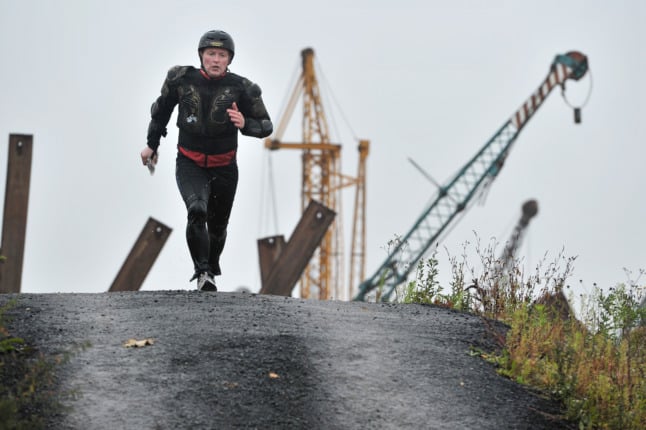
Extreme sports fanatic and ex-musician Joey Kelly scaled the width of Germany in just 18 days. Photo: picture alliance / dpa | David Ebener
One famous example of a sports hiker is the ex-musician and extreme athlete Joey Kelly, who crossed Germany on foot in just 18 days - from Wilhelmshaven to the Zugspitze (Germany's highest mountain). Another extreme hiker in the German hiking scene is Benno Schmidt - otherwise known as 'Brocken-Benno' - who has climbed the Brocken, northern Germany's highest mountain, almost 9,000 times.
On his 89th birthday in May 2021, he had to sit out the hike because of cancer, but he hasn't let the illness dampen his hopes of returning to the peaks: "I definitely want to do my 90th on the Brocken again," he says.
The naked hiker
Unlike the sports hiker who is likely to be decked out in the best ergonomic hiking kit, the naked hiker walks as God created them: in the nude. In one remote forest in the southern Harz that's a hotspot for this type of hiker, others are warned in advance with a sign. It says: "If you don't want to see a naked person, you mustn't go any further here."
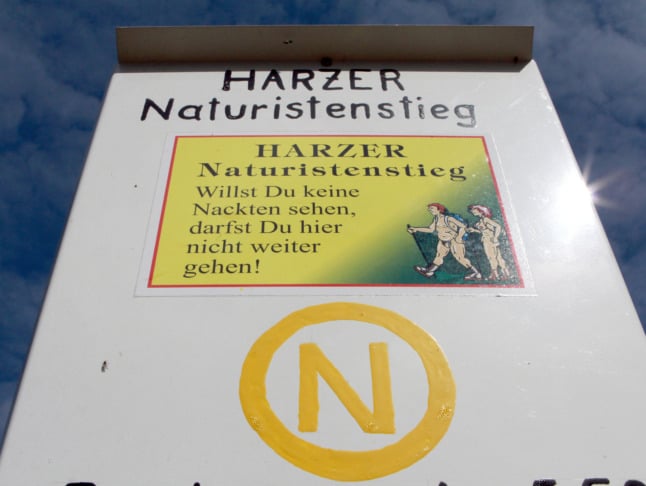
A sign warns prudish travellers to turn back if they want to avoid the naked hikers. Photo: picture alliance / Matthias Bein/dpa-Zentralbild/dpa | Matthias Bein
Behind it is the Harzer Naturistenstieg (the Harz Naturists' trail), which opened in 2010 as the first nude hiking trail in Germany. As long as the temperatures allow it, nudists are out and about over a length of 14 kilometres. In contrast to barefoot runners, however, naturist walkers only dispense with clothes from the ankles up. If you do take to the Harzer Naturistenstieg, you're unlikely to spot a naked hiker without a proper pair of boots.
It's also worth noting that anyone who decides to go walking in their birthday suit in an area that's not a designated naked hiking trail could face prosecution and arrest, according to the German Lawyers' Association. As a rule of thumb, however, the further away a nudist is from the general public, the less likely they are to run into legal issues.
WATCH Why do Germans love getting naked?
The culture hiker
Not content with soaring peaks and pine forest alone, the culture hiker is keen to combine learning with nature. You might run into this type of walking enthusiast following the trail of monastic ruins and thirstily acquiring knowledge of the past.
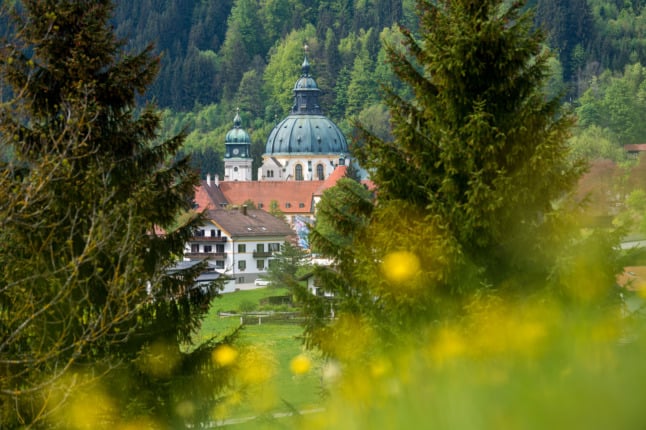
Culture hikers may find themselves on the trail of old monasteries, such as Kloster Ettal in Bavaria. Photo: picture alliance / Lino Mirgeler/dpa | Lino Mirgeler
"In many major German cities, designated routes lead on winding paths through green oases and to unexpected places," says the German Hiking Association.
READ ALSO: Waldeinsamkeit: Five of the best forest walks around Berlin
Due to the high demand, the German Hiking Institute has added two city hiking trails to the more than 600 premium hiking trails certified for Europe. For the new routes “Tecklenburger Romantik” (6.2 km in North Rhine-Westphalia) and “Frankenberger Blickwinkel” (9.2 km in Hesse) both strive for a balance between scenic paths and urban landmarks.
The night hiker
Prowling through the forest at night, the night hiker is in it for both fear and excitement.
"Even if you already know the way, you can experience it differently at night," explains Erber. As a rule, night hikes are led by a local expert who can offer guidance and share interesting facts about the route, making these nocturnal jaunts comparable with other educational hikes - such as wine or mushroom hikes.
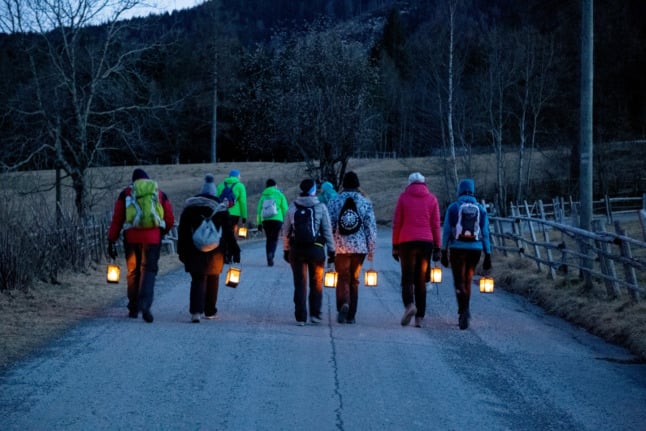
A group of lesser-spotted night hikers walk along a trail holding lanterns. Photo: picture alliance/dpa/dpa-tmn | Anita Arneitz
There are a huge range of experiences on offer in Germany for these night owls. In the Harz Mountains, animal lovers can go bat-stalking with a so-called bat detector, which makes the sounds of the animals perceptible to human ears. The romantically inclined (or werewolf enthusiast) night hiker, meanwhile, can go on a full moon ramble in locations like Lüneburg Heath in Lower Saxony.
The pilgrim hiker
Not just strong in spirit, the pilgrim hiker can also be seen as the long-distance runner among hikers, since the religious routes they follow can be thousands of kilometres long. "These are the hardcore hikers," Erber says.
The Way of St. James, one of the most famous pilgrimage routes, leads to the spiritual site of Santiago de Compostela in northwestern Spain. Though hardened hikers can travel all the way there from Germany by following one of the country's own 'Ways of St. James', many people opt to just do part of the hike from the Pyrenees in northern Spain.
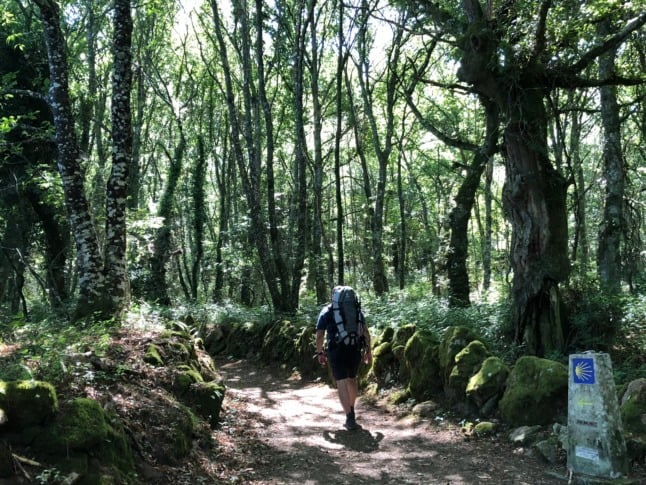
A hiker passes through an ancient forest while traversing the world-famous pilgrim route, Camino de Santiago. Photo: picture alliance/dpa/dpa-tmn | Manuel Meyer
One of the most famous pilgrim hikers is the TV entertainer Hape Kerkeling, who wrote a book about his experiences (“I'll be gone”), which was later made into a film.
An alternative to the catholic Way of St. James is the 6000 km long Jizoweg, which weaves between Buddhist centers in Europe.
Comments (9)
See Also
The nature-loving hiker
Out of the city, into the wilderness: the priority for the nature-loving hiker is getting a taste of the great outdoors. This type of hiker is, at the moment at least, the most commonly spotted variety of hiker.
READ ALSO: Six great hiking tours in the northeast of Germany
In a recent survey, 95 percent of respondents said that “experiencing nature” was their primary reason for donning their hiking boots. But could it just be the threat of coronavirus that's causing people to march through forests, low mountain ranges and alpine meadows again? Not at all, according to German Hiking Institute chairman Klaus Erber. For more than 10 years, he's been observing a growth in the popularity of hiking for pleasure.
This is also borne out by the figures: while in 2020 ten percent said they went hiking “often”, a recent survey by the Allensbach Institute for Demoscopy shows that this has already crept up to 12 percent. A representative proportion of the German-speaking population aged 14 and over in the Federal Republic was surveyed between summer 2020 and spring 2021.
According to the survey, 46.3 percent get active in nature “from time to time”, compared to 45 percent in 2020, while 41.7 percent said they “never” go hiking, compared to 45 percent the previous year. According to the German Hiking Association, there are around 200,000 kilometres of hiking trails in Germany for people to enjoy, including a number of 'premium routes' selected by the association itself.
READ ALSO: REVEALED: 10 of the best hiking day trips from Munich
The age of the average nature hiker has also changed over time - "from 60-plus two decades ago to around 47 now," Erber explains. One reason is the larger proportion of families with children who are heading out into nature. The hiking expert and geographer does not believe that the trend will abate after Corona: "If they've had a positive experience, a large proportion of people will keep it up," he said.
The serious sports hiker
In contrast to leisure or nature hikers, sports hikers are in it for the adrenaline, not to mention a heavy dose of social kudos.
“For them, it's about wracking up the kilometres,” explains Erber. You'll most likely see this type of hiker competing for badges for each of the routes they complete. Sports hikers are often organised in associations and therefore travel in groups, but sometimes they are also lone warriors.
You'll also see them with trekking poles or other gear they've bought specifically for their beloved active hobby.

Extreme sports fanatic and ex-musician Joey Kelly scaled the width of Germany in just 18 days. Photo: picture alliance / dpa | David Ebener
One famous example of a sports hiker is the ex-musician and extreme athlete Joey Kelly, who crossed Germany on foot in just 18 days - from Wilhelmshaven to the Zugspitze (Germany's highest mountain). Another extreme hiker in the German hiking scene is Benno Schmidt - otherwise known as 'Brocken-Benno' - who has climbed the Brocken, northern Germany's highest mountain, almost 9,000 times.
On his 89th birthday in May 2021, he had to sit out the hike because of cancer, but he hasn't let the illness dampen his hopes of returning to the peaks: "I definitely want to do my 90th on the Brocken again," he says.
The naked hiker
Unlike the sports hiker who is likely to be decked out in the best ergonomic hiking kit, the naked hiker walks as God created them: in the nude. In one remote forest in the southern Harz that's a hotspot for this type of hiker, others are warned in advance with a sign. It says: "If you don't want to see a naked person, you mustn't go any further here."

A sign warns prudish travellers to turn back if they want to avoid the naked hikers. Photo: picture alliance / Matthias Bein/dpa-Zentralbild/dpa | Matthias Bein
Behind it is the Harzer Naturistenstieg (the Harz Naturists' trail), which opened in 2010 as the first nude hiking trail in Germany. As long as the temperatures allow it, nudists are out and about over a length of 14 kilometres. In contrast to barefoot runners, however, naturist walkers only dispense with clothes from the ankles up. If you do take to the Harzer Naturistenstieg, you're unlikely to spot a naked hiker without a proper pair of boots.
It's also worth noting that anyone who decides to go walking in their birthday suit in an area that's not a designated naked hiking trail could face prosecution and arrest, according to the German Lawyers' Association. As a rule of thumb, however, the further away a nudist is from the general public, the less likely they are to run into legal issues.
WATCH Why do Germans love getting naked?
The culture hiker
Not content with soaring peaks and pine forest alone, the culture hiker is keen to combine learning with nature. You might run into this type of walking enthusiast following the trail of monastic ruins and thirstily acquiring knowledge of the past.

Culture hikers may find themselves on the trail of old monasteries, such as Kloster Ettal in Bavaria. Photo: picture alliance / Lino Mirgeler/dpa | Lino Mirgeler
"In many major German cities, designated routes lead on winding paths through green oases and to unexpected places," says the German Hiking Association.
READ ALSO: Waldeinsamkeit: Five of the best forest walks around Berlin
Due to the high demand, the German Hiking Institute has added two city hiking trails to the more than 600 premium hiking trails certified for Europe. For the new routes “Tecklenburger Romantik” (6.2 km in North Rhine-Westphalia) and “Frankenberger Blickwinkel” (9.2 km in Hesse) both strive for a balance between scenic paths and urban landmarks.
The night hiker
Prowling through the forest at night, the night hiker is in it for both fear and excitement.
"Even if you already know the way, you can experience it differently at night," explains Erber. As a rule, night hikes are led by a local expert who can offer guidance and share interesting facts about the route, making these nocturnal jaunts comparable with other educational hikes - such as wine or mushroom hikes.

A group of lesser-spotted night hikers walk along a trail holding lanterns. Photo: picture alliance/dpa/dpa-tmn | Anita Arneitz
There are a huge range of experiences on offer in Germany for these night owls. In the Harz Mountains, animal lovers can go bat-stalking with a so-called bat detector, which makes the sounds of the animals perceptible to human ears. The romantically inclined (or werewolf enthusiast) night hiker, meanwhile, can go on a full moon ramble in locations like Lüneburg Heath in Lower Saxony.
The pilgrim hiker
Not just strong in spirit, the pilgrim hiker can also be seen as the long-distance runner among hikers, since the religious routes they follow can be thousands of kilometres long. "These are the hardcore hikers," Erber says.
The Way of St. James, one of the most famous pilgrimage routes, leads to the spiritual site of Santiago de Compostela in northwestern Spain. Though hardened hikers can travel all the way there from Germany by following one of the country's own 'Ways of St. James', many people opt to just do part of the hike from the Pyrenees in northern Spain.

A hiker passes through an ancient forest while traversing the world-famous pilgrim route, Camino de Santiago. Photo: picture alliance/dpa/dpa-tmn | Manuel Meyer
One of the most famous pilgrim hikers is the TV entertainer Hape Kerkeling, who wrote a book about his experiences (“I'll be gone”), which was later made into a film.
An alternative to the catholic Way of St. James is the 6000 km long Jizoweg, which weaves between Buddhist centers in Europe.
Join the conversation in our comments section below. Share your own views and experience and if you have a question or suggestion for our journalists then email us at [email protected].
Please keep comments civil, constructive and on topic – and make sure to read our terms of use before getting involved.
Please log in here to leave a comment.